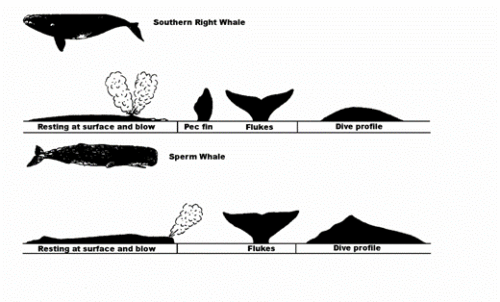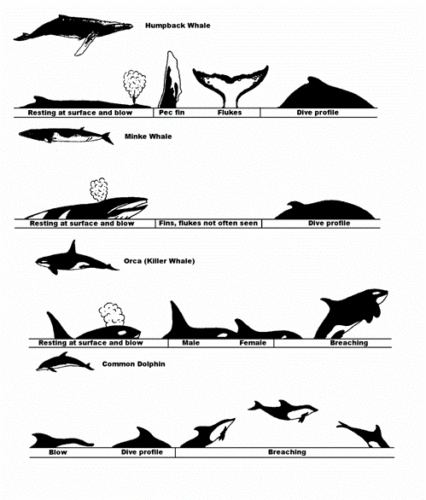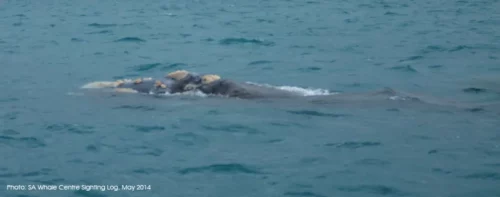I recently stumbled upon this guide to the identification of whale species (that may be seen off of our coast) from one of our 2005 newsletters: –
How you can identify the most popular whale species off our coast
(Courtesy SA Whale Centre: www.sawhalecentre.com )
Aside from our beloved Southern Right whale, a few other whale species seem to be the favourite subjects of school projects and general interest: Humpback, Sperm whales and Orcas.
Each species can be sighted in SA, and you can tell them apart easily by comparing the shape of their blow and the size and shape of their tail flukes and pectoral fins.

HUMPBACK WHALES
Humpback whales are found in all oceans of the world and grow to an average length of 15 metres. They have the longest flippers of all the whales, which make up to one-third of the total body length. The upper body colour is black while the underside of the flippers, belly and flanks can be white or black. The tail has a ragged edge and on the head are bumps and knobs, called tubercles, with barnacles growing on them.
Humpback whales got their common name from the way they dive: when they prepare for a dive they raise and bend their back, emphasising the hump in front of the dorsal fin. Because humpback whales are slower swimmers and very curious, they were easy prey to both the early and modern whalers, and the population was eventually decimated by whaling. They are now fully protected in Australian waters.
Humpback whales eat krill and small schooling fishes such as herring, mackerel and capelin.
They have a unique and fascinating method of catching their prey called “bubble netting”. The whale dives below a school of fish blowing a stream of bubbles from its blowhole. As the bubbles rise they form a column that surrounds the fish and forces it to the surface. With mouth open, the whale swims up through the column, engulfing the fish and many litres of water. A whale can adjust the size of its “net” to hold prey of varying size.
In the breeding season, vigorous males “sing” long complex “songs”. A song is a mixture of sounds including moans, cries, clicks, squeaks, roars, whistles and other strange noises. It can last from 5 to 30 minutes, and is often repeated identically for hours. It is thought that songs maybe used to lure females or frighten males away.
Humpback whales are considered to be one of the more gentle whales but can become very aggressive when trying to win the affection of a female. They will head lunge, head butt, tail slap, physically displace, charge and ultimately strike their rivals. Although wounds maybe caused during this activity they are usually only superficial.

SPERM WHALE
Sperm whales are the largest of the toothed whales. Males can reach a length of up to 18 metres and weigh approximately 45 tonnes, while females are smaller and average about 11 metres. Sperm whales are dark-brown or dark-grey in colour and their skin is of a rippled, corrugated appearance. Their blowhole is situated on the left side of the snout so that when they blow it is at an angle reaching up to 5 metres high. They are found around the deeper waters off continental shelves all around the world.
Sperm whales were named as such because in early whaling days it was mistakenly thought that the white, waxy substance produced in their huge box-like head was part of the reproductive system.
Sperm whale oil was once the single most important product of commercial whaling. Spermaceti oil is very rich and preferable to other oils because of its purity, lubrication and speed that it can liquify. It was used for making candles, cosmetics, soaps, detergents, machinery oil as well as many other products.
The ivory teeth of sperm whales were once used for buttons, piano keys, markers in games and also as a decorative form of artwork known as Scrimshaw. Sperm whales were one of the most heavily exploited whales and the last whale taken in Australian waters was at Albany, Western Australia, in 1978.
The main diet for Sperm whales is squid and fish. Large males routinely dive to 800 metres or more and have been recorded down to 3,000 metres. They can remain submerged for up to 90 minutes and the longest recorded dive last 2 hours and 18 minutes.
ORCAS
Orca whales are also known as Killer whales, and are regarded as the ocean’s top predator. These toothed whales hunt in packs, and feed on a wide range offish as well as seals, dolphins, other whales, including the giant Blue whale, and sea birds. Killer whales live in ‘pods’ or family units, with up to 40 animals in each pod. They tend to stay together for life, although sometimes a very
large pod will split into two.
Killer whales are found throughout the world’s oceans, and are recognised by their striking shiny black-and-white skin pattern. Males can reach a length of up to 9 metres, while females are smaller, and measure about 7 metres. Calves are born at an approximate length of 2 metres.
Male Killer whales are distinguished by their very erect, tall and sharply triangular dorsal fin. The female dorsal fin is shorter and slightly curved. The flippers are broad and paddle-shaped. Killer whales are very active, being robust and fast swimmers, that frequently breach and spy-hop.
Even though Orcas were not hunted commercially, they were known to have assisted whalers by alerting them to the passage of other whales. They would lob tail, breach and then harass and herd other whales before and during capture.
For their reward the whalers would leave the tongue and lips for the Killer whales, items which they regard as delicacies.


(Taken from our August 2005 Newsletter, No.324 – http://seadragon.podzone.org/nletters/august2005.htm and courtesy of the SA Whale Centre at Victor Harbor)

How often do Killer Whales target White Sharks? I’d guess, but I am only guessing, that because White sharks are mainly solitary, hunting them would be a poor nutritional strategy. But if they encounter one by chance, are they likely to attack it? (Perhaps yes, if the pod has new babies to protect, but even then it shouldn’t be hard for the adult Whales to defend their young without killing the shark. )
Further guesswork:- maybe in nature the main oceanic travel routes for each species have evolved to be sufficiently different that the 2 species don’t often encounter each other?
Or perhaps Great White sharks have evolved to actively avoid their nemesis.